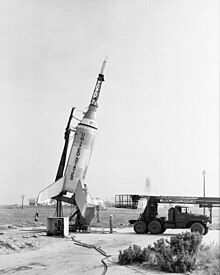 The Little Joe 1 launch vehicle with Mercury capsule, August 1959. | |
| Function | Uncrewed capsule testing |
|---|---|
| Manufacturer | North American Aviation |
| Country of origin | United States |
| Size | |
| Height | 17 m (55 ft) |
| Stages | 2 |
| Capacity | |
| Payload to suborbital | |
| Mass | 1,400 kg (3,000 lb) |
| Launch history | |
| Status | Concluded |
| Launch sites | Wallops Island, Virginia |
| Total launches | 8 |
| Success(es) | 6 |
| Failure(s) | 2 |
| Boosters | |
| Powered by | Recruit rockets |
| Maximum thrust | 668 kN (150,000 lbf) |
| Burn time | 1.53 s |
| Propellant | solid |
| First stage – Sustainer | |
| Powered by | Castor |
| Maximum thrust | 1,036 kN (233,000 lbf) |
| Burn time | 37 s |
| Propellant | Solid |
Little Joe was a solid-fueled booster rocket used by NASA for eight launches from 1959 to 1961 from Wallops Island, Virginia to test the launch escape system and heat shield for Project Mercury capsules, as well as the name given to the test program using the booster. The first rocket designed solely for crewed spacecraft qualifications, Little Joe was also one of the pioneer operational launch vehicles using the rocket cluster principle.
The Little Joe name has been attributed to Maxime Faget at NASA's Langley Research Center in Hampton, Virginia. He based the name on four large fins which reminded him of a slang term for a roll of four in craps.[1]
A successor, Little Joe II, was used for flight testing of the Apollo launch escape system from 1963 to 1966.
- ^ Helen T. Wells; Susan H. Whiteley & Carrie E. Karegeannes. Origin of NASA Names. NASA Science and Technical Information Office. p. 10.